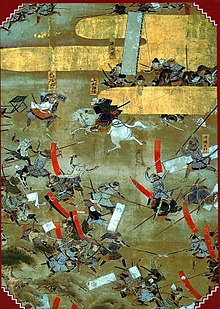Koryu
| Koryū | |||||

Centuries of feudal warfare in Japan, and the desire to perfect the skills for war, led to the creation of the traditional schools of Japanese martial arts.
|
|||||
| Japanese name | |||||
|---|---|---|---|---|---|
| Kanji | 古流 (Koryū) or 古武道 (Kobudō) |
||||
| Hiragana | こりゅう | ||||
|
|||||
| Transcriptions | |
|---|---|
| Revised Hepburn | Koryū and Kobudō |
Koryū (古流?, old style) and kobudō (古武道?, ancient martial arts) are Japanese terms that are used to describe Japanese martial arts that predate the Meiji restoration (1868). The term is contrasted with Gendai budo "modern martial arts" (or shinbudo "new martial arts") which refer to schools developed after the Meiji Restoration.
In Japanese, kobudō 古武道 and ko-ryū 古流 are normally treated as synonyms (for example, All Japan Kendo Federation,). In English, the International Hoplology Society makes a distinction between kobudō and ko-ryū concerned the origin and the difference between the ranking of priorities concerning combat, morals, discipline and/or aesthetic form.
This term literally translates as " " (ko—old, ryū—school) or "traditional school". Koryū is also a general term for Japanese schools of martial arts that predate the Meiji Restoration (1868) which sparked major socio-political changes and led to the modernization of Japan.
The system of koryū is considered in following priorities order: 1) combat, 2) discipline 3) morals.
Kobudō (古武道 kobudō?) is a Japanese term for a system that can be translated as (old) (martial) (way) "old martial art"; the term appeared in the first half of the seventeenth century. Kobudō marks the beginning of the Tokugawa period (1603-1868) also called the Edo period, when the total power was consolidated by the ruling Tokugawa clan.
...
Wikipedia
